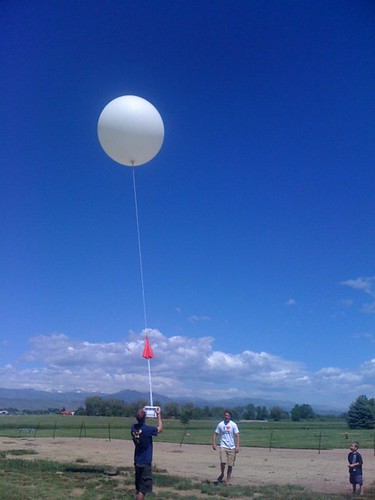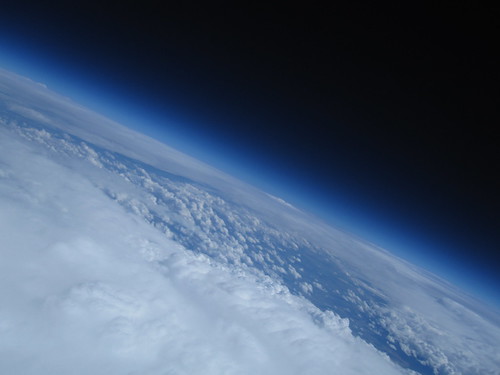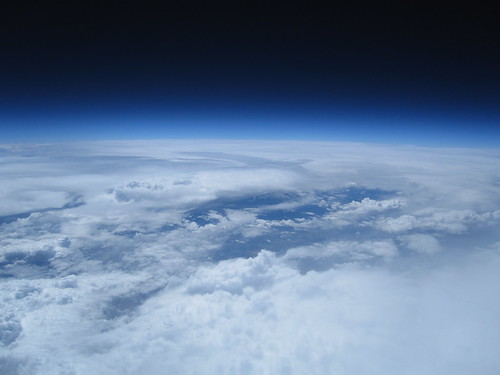High Altitude Balloon Launch
High Altitude Balloons
A story of the electronics and logistics of launching a high altitude balloon.
Let me jump to the punch line: As much as it pains me to say it, we lost the balloon and payload.
There's a box of electronics sitting out there in eastern Colorado right now. But document your failures, right? So here is a tutorial to show you what I learned from a painful adventure. But if you happen to come across a styrofoam box full of 'SparkFun' marked electronics (with 'Nathan Seidle' and a phone number printed on it), please shoot me an email: spark@sparkfun.com. I will become your new best friend.
This is the story of a balloon, a parachute, and a box full of electronics.
The following files are open source design files and firmware available free of charge. If you use them in your own project, let us know! We'd love to hear about your project or adventure.
Downloads:
- Main flight computer: Schematic, Eagle files, Firmware
- Load controller (heater and cut-down): Schematic, Eagle files, Firmware
-
CHDK 20 second timer script
Why?
Why would someone want to do this? Because it's a dream of mine to send something up really high, take some readings, some pictures, maybe some video, and come back down. What does it look like at 100,000ft? Sure, we've all seen NASA photos, and weather photos. Shoot, google maps is the encapsulation of looking down. But those photos seem surreal. I want to take my own.
But in failure, steal other people's work! Because my balloon was lost, I asked David Stillman (IT guru here at SparkFun) to use some photos and video from his launch a few weeks before my unsuccessful launch. Check that out! That's space! He got a box of electronics to the edge of space and captured a photo (actually many).
Who wouldn't want to do something like this? (Ok, maybe lots of people) When I was a student at CU, all the aerospace kids got to do balloon satellite projects. Us Electrical Engineering majors got to do nothing of the sort. Ever since college, I've wanted to launch my own balloon and payload. But I assumed it required lots of permits, expensive tools and tracking gear, and was limited to the domain of research. I believed this until one of the IT guys at SparkFun (StillDavid) walked into my office and started asking me questions about how GPS units perform above 50,000ft. "Why do you need a GPS lock above 50,000ft?" I asked. High altitude balloons was his side project. After talking for a few minutes, I discovered that amateurs could launch their own balloons with a little work. And I was hooked.
So that's the idea, build a payload with a lot of sensor, get a camera taking a bunch of pictures, include a GPS with transmitter for location and tracking, fill up a balloon, and release! Sound easy? It is, it just takes a lot of time and learning. This turned into such a large tutorial, we've broken it up into HAB chapters.
Next page - Sensor system, Flight Computer and Radio System
High Altitude Balloon Page:




Thank you for the tutorial. We just completed a HAB Launch with our cub scout den of Pack 323 to get their Engineering badge. The tutorial helped us successfully launch and recover our balloon. Check out the youtube video of our launch. Pack 323 High Altitude Balloon or search "Pack 323 High Altitude Balloon" It was a project that inspired our kids and the memories will last a lifetime.
That's fantastic! Thanks for the link to the video!
Keep up the hope. I lost my first balloon payload and 3 months later a hiker found it and gave me a call.
Really?! I had sort of given up - thanks for the hopeful comment!
You did put your contact information in the payload, right? :)
You only read the story until the punch line, right?
Apparently. Doh. (Actually, I'd read the version that is currently posted on the homepage, which doesn't mention that. Clicked over to this one somehow, and glanced down at the comments without reading the whole article.)
I recently launched a balloon from Rochester,NY back in early May of 2013.It headed North and was last heard after 5 hours or so in the North/East direction.It has my email and information inside the waterproof container with the 10 meter radio beacon @ 28.224 mhz.It also runs from solar cells.Last year we sent the same payload which was found by hunters 6 months later.Hoping this one will be found or heard again. Videos of past/present launches here > http://www.youtube.com/channel/UCrvhnzZgEhEPRxzjpzUw3ug Jim,N2NXZ
Mind if I ask the details about your 10m beacon? I'm looking to do a zero pressure launch at some point maybe this fall/early winter and am looking for a backup for my APRS beacon.
Great videos!
I will be glad to give you information regarding the balloon transmitter.It is a very simple circuit using a single 2n2222 transistor.As small as it is,the signal is very strong at high altitudes as mine was heard for over 5 hours after launch. I would love to try my hand at APRS...but the cost is out of my league.Here is a photo of the transmitter using a crystal from an old 56k modem (28.224) and a picaxe keyer circuit.Look me up on QRZ.com for my email if you want a schematic. http://s430.photobucket.com/user/N2NXZ/media/DSCF0038.jpg.html?sort=3&o=34
Jim,N2NXZ
Why wasn't there a GPS included in it? wouldn't that be helpful? lol It seems like the right thing to include when sending a ballon 100,000ft into the air and don't know where it will come down!
Even better, include the package tracker!!
Can you clarify what license the firmware is under? The files say they're Copyright Spark Fun Electronics and Nathan Seidle with no indication of the license.
The defs.h file from AVR Libc is under the GPL, so I'm guessing the whole package is as well?
We'd like to use these as the basis for a balloon our hackerspace is working on but need to verify what license you're using.
High altitude balloons are cool, but our project is far more ambitious:
White Star Balloon
We are working on landing a box of used balloon parts in Europe, launching from Louisville, KY. There will be a few SparkFun parts in the box too. Definitively one of the most interesting projects I've been a part of.
There' a bunch of considerations launching in other countries as well. Also, get your HAM license! it's an afternoon read to pass the exam and it opens a lot of different radio approaches
Here we ended up using a MicroTrak from Byonics with a Lassen GPS from SFE (it works above 90k ft) through the logging board SFE used to sell for $35 (which died 8 mins into flight...whee)
Enjoy the countdown in Khmer and the views of the rice fields!
http://www.youtube.com/watch?v=0gn9tuttCQg
http://www.slideshare.net/edjez/our-pale-blue-dot-bcpp2010
http://www.phnompenhpost.com/index.php/2010100342432/National-news/cambodia-2010-a-space-oddity.html
http://www.phnompenhpost.com/index.php/2010100643877/LIFT/whats-new.html
very cool! You mention that: "that amateurs could launch their own balloons with a little work". So I was wondering if you had to notify the FAA or worry about where to start.
A friend of mine recently did a project just like this. To ensure he was able to recover his camera and other equipment, he attached a Spot Satellite Messenger GPS to it. In effect, it gets the GPS data and uploads it to the internet every 10 minutes. It stopped working after a certain altitude, but eventually when the balloon fell, he was able to locate it.
It's not a cheap thing, but it's an idea for an all-in-one package.
posted on DIYDRONES in part
... I suggest that you seriously consider adding a transponder on the amateur bands. I'm sure local CO hams would willingly assist and you can run amateur equipment i.e. TX with out a licence when supervised by a licenced amateur at least for the GPS data. You will have ham ground stations who will track your launch including setup such as we use here http://www.wincube.ca/bcube.html and http://www.wincube.ca/amateurradio.html . We use 300mw transmitters at 144.390 MHz for GPS data and signals are heard up to 50 miles with piano wire omni directional antennas mounted horizontally 1/4 wave 19 1/2 inches aprox. Less antenna than I have on my EZ-Star for 72 MHz If the balloon goes beyond local reception another amateur will surely hear your beacon and GPS and relay it to the internet where to can track in almost real time at www.aprs.fi.
Alan VE4YZ
...or you could just get a license. It's ~$10.